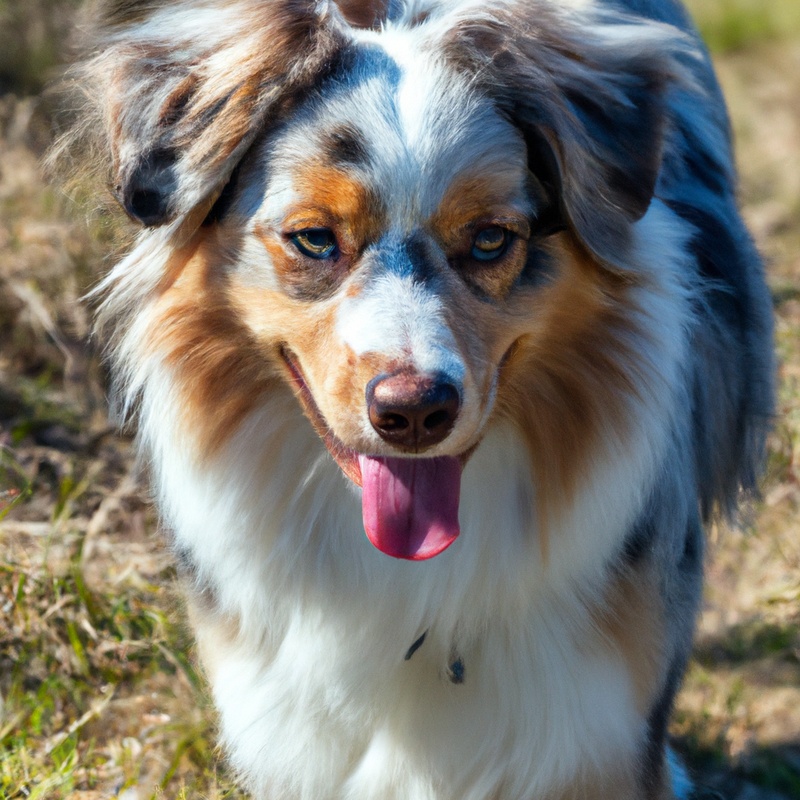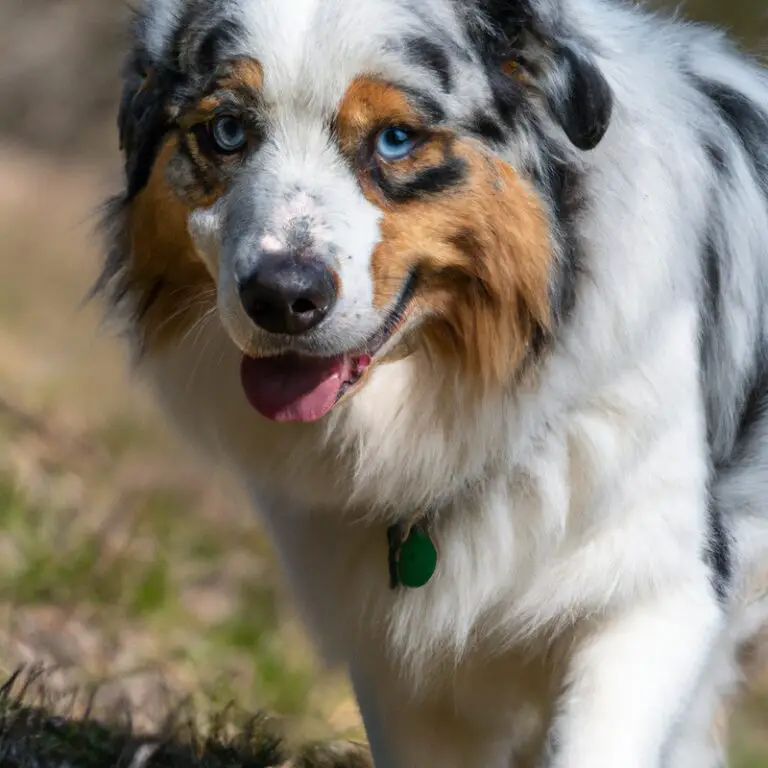How Do Australian Shepherds Behave When Introduced To New Turtles Or Tortoises?
Key Takeaways:
- Australian Shepherds may exhibit curiosity and interest when introduced to new turtles or tortoises.
- They can display gentle and cautious behavior towards these reptiles.
- Australian Shepherds may require proper introduction and socialization to ensure a positive interaction with turtles or tortoises.
- Supervision is important to prevent any potential harm to the reptiles or the dog.
Imagine introducing two creatures from vastly different worlds. On one side, we have the lively and intelligent Australian Shepherds, known for their boundless energy and loyalty.
On the other side, we have the serene and slow-moving turtles or tortoises, captivating us with their ancient charm.
What happens when these two worlds collide? As an expert in canine behavior, I can shed some light on the fascinating interactions between Australian Shepherds and these shelled creatures.
From curiosity to vigilance, chasing to reactivity, we’ll explore the range of reactions these dogs exhibit, and how to ensure a positive and harmonious introduction.
So, brace yourself for an insightful journey into the intriguing dynamics between these unlikely companions.
Initial Introduction of Australian Shepherds and Turtles/Tortoises
Preparing for the Introduction
Preparing for the Introduction involves taking certain steps to ensure a safe and smooth transition for both your Australian Shepherd and the new turtle or tortoise. The first step is to create a designated area for the turtle or tortoise, ensuring that it is secure and escape-proof.
This can be achieved by using a properly enclosed tank or habitat.
Next, it’s important to familiarize your Australian Shepherd with the presence of the turtle or tortoise without direct contact. You can do this by allowing your dog to observe the new pet from a safe distance, such as through a baby gate or behind a glass enclosure.
This will help your dog become accustomed to the sight, sound, and scent of the turtle or tortoise.
Additionally, it’s crucial to ensure that the turtle or tortoise has a secluded area within their habitat where they can retreat and feel safe. This will help prevent stress or harm to either pet during the introduction process.
Before allowing any direct interaction, make sure that your Australian Shepherd is well-trained in basic obedience commands, such as “sit,” “stay,” and “leave it.” These commands will provide you with more control and help prevent any unwanted behavior during the introduction.
Finally, when the time comes for an actual introduction, it’s important to closely supervise and control the interaction. Start with short and supervised encounters, gradually increasing the duration and level of interaction as both pets become more comfortable with each other.
Supervised Encounters and Observations
Supervised encounters and observations are essential when introducing Australian Shepherds to turtles or tortoises. I recommend closely monitoring their interactions to ensure the safety of both pets.
Watch for signs of curiosity, playfulness, or chasing behaviors, as well as any reactive or excited responses from your dog.
It’s important to create a controlled environment and provide guidance during these encounters. By supervising and observing their behavior, you can better understand how your Australian Shepherd reacts to turtles or tortoises and take necessary precautions.
Australian Shepherds’ Behavioral Reactions to Turtles/Tortoises
Curiosity and Playfulness
Australian Shepherds are known for their curious and playful nature, and this extends to their interactions with turtles or tortoises. When introduced to these reptiles, Australian Shepherds may display a combination of curiosity and playfulness.
They may approach the turtle or tortoise with gentle sniffing, nudging, or even pawing.
It’s important to note that every dog is unique, so their reactions may vary slightly. Some Australian Shepherds may even try to engage the turtle or tortoise in play, using their herding instincts to nudge or circle around them.
It’s essential to supervise these interactions to ensure the safety of both the dog and the reptile.

Vigilance and Watchfulness
When it comes to introducing Australian Shepherds to new turtles or tortoises, it’s important to understand their behavioral reactions. One aspect to look out for is their vigilance and watchfulness.
Australian Shepherds are naturally attentive and observant dogs, so they may exhibit a high level of alertness when encountering these reptiles.
During the introduction, you may notice that your Australian Shepherd becomes very focused on the turtle or tortoise. They may closely watch their movements and posture, showing curiosity about this new creature in their environment.
It’s their way of assessing the situation and trying to understand if the reptile poses any threat.
Australian Shepherds have herding instincts, and their vigilance could be heightened when they encounter animals they perceive as potential prey. Although turtles and tortoises are not prey for dogs, the sight of a small, slow-moving creature might trigger their chase instinct.
So, it’s important to closely supervise their interactions and ensure the safety of both the dog and the reptile.
To manage your Australian Shepherd’s vigilance and watchfulness during these introductions, you can redirect their focus using positive reinforcement techniques. By rewarding them for calmly observing the turtle or tortoise without engaging in chasing or intense reactions, you can encourage a more relaxed and positive interaction.
Remember, every dog is unique, so their responses may vary.
Some Australian Shepherds may show a higher level of vigilance and take longer to adjust, while others may quickly become comfortable in the presence of turtles or tortoises. Patience, consistency, and ongoing socialization will help your Australian Shepherd develop a calm and positive attitude towards these reptiles.

Chasing or Pursuing Behaviors
When it comes to the behavior of Australian Shepherds towards turtles or tortoises, one common reaction is chasing or pursuing. Australian Shepherds have a herding instinct, which can make them prone to wanting to chase and round up these smaller creatures.
It’s important to be aware of this behavior and take necessary precautions to ensure the safety of both the dog and the turtle or tortoise.
Monitoring and redirecting the behavior through positive reinforcement training can help minimize chasing or pursuing behaviors. Keep in mind that each dog is unique, so it’s crucial to observe your Australian Shepherd’s behavior and adjust your training approach accordingly.
Reactivity and Excitement Levels
When it comes to the reactivity and excitement levels of Australian Shepherds when introduced to turtles or tortoises, it is crucial to remember that each dog is unique and may react differently. However, Australian Shepherds are generally known for their high energy and curiosity, which can contribute to heightened reactivity and excitement levels.
When encountering turtles or tortoises for the first time, Australian Shepherds may display a range of reactions.
Some dogs may become extremely excited and exhibit playful behavior, such as barking or chasing the slow-moving creatures. Others may exhibit vigilance and watchfulness, observing the reptiles from a distance and monitoring their movements.
It is essential for pet owners to pay attention to their Australian Shepherds’ behavior during these interactions.
Excessive reactivity or excitement can potentially escalate into chasing or pursuing behaviors, which could possibly lead to stress or harm to the turtles or tortoises. To manage the reactivity and excitement levels, positive reinforcement techniques can be implemented.
Rewarding calm behavior and redirecting their attention to more appropriate activities can help Australian Shepherds develop a positive association with the presence of turtles or tortoises.
Consistency and patience in training are crucial for achieving desired results. Gradual exposure and ongoing socialization can also contribute to reducing reactivity and excitement levels.
By introducing Australian Shepherds to turtles or tortoises in a controlled environment and providing supervised encounters, dogs can become more accustomed to the presence of these reptiles over time.

Training Australian Shepherds for Calmness and Positive Interaction
Positive Reinforcement Techniques
Positive reinforcement techniques are an effective way to train Australian Shepherds for calmness and positive interaction with turtles or tortoises. When introducing your Australian Shepherd to these reptiles, it’s important to reward desired behaviors with treats, praise, or playtime.
For example, if your dog displays calm and gentle behavior around the turtle or tortoise, offer them a treat or engage in a fun game.
This positive reinforcement helps your dog associate positive experiences with the presence of turtles or tortoises. Consistency and patience in training are key, as it may take time for your dog to adjust.
Gradual exposure and ongoing socialization are also important.
Start with short, supervised encounters and gradually increase the duration as your dog becomes more comfortable. By using positive reinforcement techniques, you can create a positive association between your Australian Shepherd and turtles or tortoises, fostering a harmonious and enjoyable relationship.
Consistency and Patience in Training
Training Australian Shepherds for calmness and positive interaction with turtles or tortoises requires consistency and patience. Building a solid foundation of obedience and basic commands is key.
I spend time every day working on commands like sit, stay, and come.
I reward my Australian Shepherd with treats and praise to reinforce good behavior. It’s important to be patient and understanding, as learning takes time.
I gradually introduce my dog to turtles or tortoises in a controlled environment, allowing them to get comfortable with each other over time.
By being consistent and patient in training, I have been able to foster a calm and positive relationship between my Australian Shepherd and turtles.
Gradual Exposure and Ongoing Socialization
Gradual exposure and ongoing socialization are key when introducing Australian Shepherds to turtles or tortoises. Start by allowing them to observe the new pets from a distance, gradually decreasing the distance over time.
This helps them become comfortable with the sight, smell, and presence of the turtles or tortoises.
Additionally, it’s important to provide positive reinforcement and rewards during the process. This can be in the form of treats, praise, or playtime.
By associating positive experiences with the turtles or tortoises, you’re encouraging your Australian Shepherd to view them in a positive light.
Consistency and patience are crucial throughout the entire process. Every dog is different, so the timeline for gradual exposure may vary.
Allow your Australian Shepherd to dictate the pace, and never force them into interactions they’re not ready for.
Ongoing socialization is necessary to ensure your Australian Shepherd continues to feel comfortable and relaxed around the turtles or tortoises. Regular exposure to and positive interaction with the new pets will help strengthen the bond and increase their level of comfort.
Remember to monitor the stress levels of both your Australian Shepherd and the turtles or tortoises during interactions.
If any signs of anxiety or aggression are shown, take a step back and reassess the situation. Consulting with a professional dog trainer can also be helpful for guidance and support.
Gradual exposure and ongoing socialization are crucial in fostering a positive and harmonious relationship between your Australian Shepherd and turtles or tortoises.
With time, patience, and positive reinforcement, they can learn to coexist peacefully and even develop a bond of friendship.
Potential Challenges and Precautions
Preexisting Prey Drive in Australian Shepherds
Australian Shepherds have a preexisting prey drive, which is a strong instinct to chase and capture small animals. This behavior is deeply ingrained in their genetic makeup and stems from their herding background.
When introduced to turtles or tortoises, Australian Shepherds may exhibit a heightened interest in these slow-moving creatures.
They may see them as potential prey and display behaviors such as stalking, chasing, or even attempting to nip at them. It is important for pet owners to understand and be aware of their Australian Shepherd’s prey drive when introducing them to turtles or tortoises.
This instinctual behavior can be challenging to modify, but with proper training and management, it is possible to ensure a safe and positive interaction between the two.
Keeping the Australian Shepherd on a leash or using baby gates to create a controlled environment can prevent any potential harm to the turtles or tortoises. Additionally, providing ample physical and mental stimulation through activities like obedience training, puzzle toys, and regular exercise can help redirect the Australian Shepherd’s energy.
It is crucial to supervise the interactions closely and intervene if any chasing or aggressive behavior is exhibited towards the turtles or tortoises.
This may involve redirecting the Australian Shepherd’s attention to a toy or engaging them in a more suitable activity. Socialization and exposure to various stimuli from an early age can also help in shaping the Australian Shepherd’s behavior towards turtles or tortoises.
Gradually introducing them to the presence of these creatures and pairing it with positive experiences can reduce their prey drive response over time.
Overall, understanding and managing the preexisting prey drive in Australian Shepherds is essential when introducing them to turtles or tortoises. By being proactive, patient, and providing appropriate training, it is possible to create a safe and harmonious environment for both the Australian Shepherd and the turtles or tortoises.
Safety Measures for Turtles and Tortoises
To ensure the safety of your turtles and tortoises when introducing them to Australian Shepherds, there are a few precautions you should take. Here are some safety measures to keep in mind:
- Separate Spaces: Create a designated area for your turtles or tortoises that is secure and inaccessible to the Australian Shepherd. This can be a separate enclosure or a sectioned-off area within your home or yard. This will prevent any accidental interactions or potential harm.
- Supervision: Whenever the Australian Shepherd and the turtles or tortoises are allowed to be together, ensure that there is constant supervision. This will allow you to intervene immediately if any aggressive or predatory behavior is observed.
- Physical Barriers: If necessary, use physical barriers such as fences or gates to create a buffer zone between the Australian Shepherd and the turtles or tortoises. This can help prevent any accidental contact or potential harm.
- Feeding Separately: Feed your Australian Shepherd and the turtles or tortoises in separate areas to avoid any competition or conflicts over food. This will help maintain a peaceful environment during mealtime.
- Professional Guidance: If you are unsure about how to introduce your Australian Shepherd to turtles or tortoises, it can be beneficial to seek advice from a professional trainer or animal behaviorist. They can provide guidance specific to your situation and help you ensure a safe introduction.
Monitoring Stress Levels of Pets during Interactions
When we introduce our Australian Shepherds to new turtles or tortoises, it’s important to monitor the stress levels of our pets during these interactions. Stress can affect their overall well-being and behavior, so it’s crucial to ensure that they are comfortable and relaxed.
One way to monitor stress levels is to observe their body language.
Look for signs of agitation, such as excessive panting, pacing, whining, or growling. These are indications that your Australian Shepherd may be feeling stressed or anxious.
Another important aspect to consider is their interaction style.
If your dog is constantly barking, lunging, or trying to chase the turtle or tortoise, it may be a sign that they are not comfortable with the situation. It’s important to intervene and redirect their attention to something more positive to help them relax.
Additionally, pay attention to any changes in appetite or sleep patterns.
If your Australian Shepherd is refusing to eat or experiencing difficulty sleeping after the interaction, it may be a sign of elevated stress levels. Remember, every dog is unique, and their stress levels may vary.
By closely monitoring their behavior and reactions, we can ensure their well-being and make adjustments if needed during future interactions with turtles or tortoises.
Final Verdict
Introducing Australian Shepherds to turtles or tortoises can be a fascinating experience. These intelligent and energetic dogs often display curiosity, playfulness, and vigilance when encountering these reptiles.
However, caution must be exercised due to potential chasing or pursuing behaviors.
Training is crucial to ensure positive interaction, focusing on positive reinforcement techniques, consistency, and gradual exposure. While there may be challenges due to the breed’s prey drive, taking safety measures and monitoring stress levels can help create a harmonious environment.
Overall, with proper preparation, supervision, and training, Australian Shepherds can develop a calm and positive relationship with turtles and tortoises.







